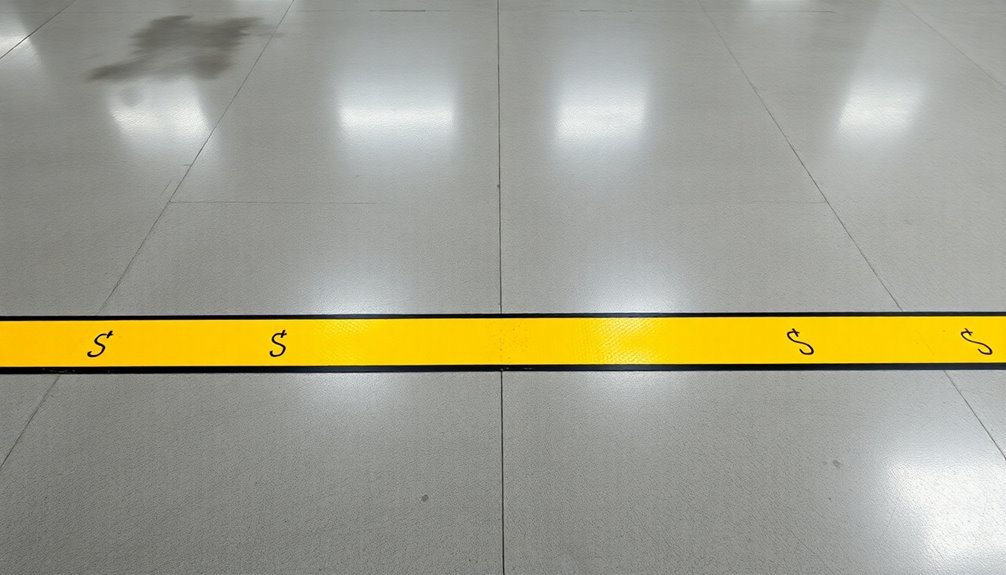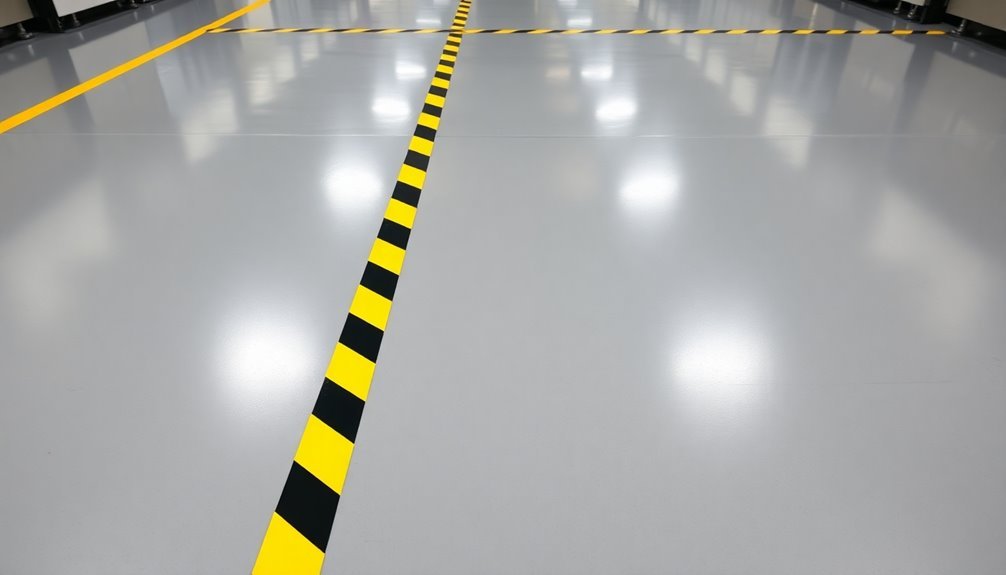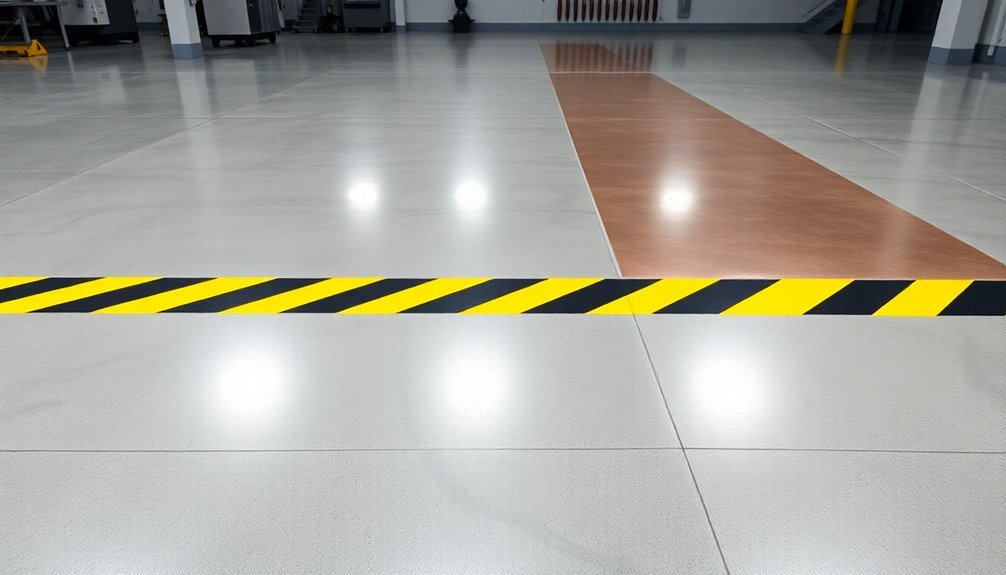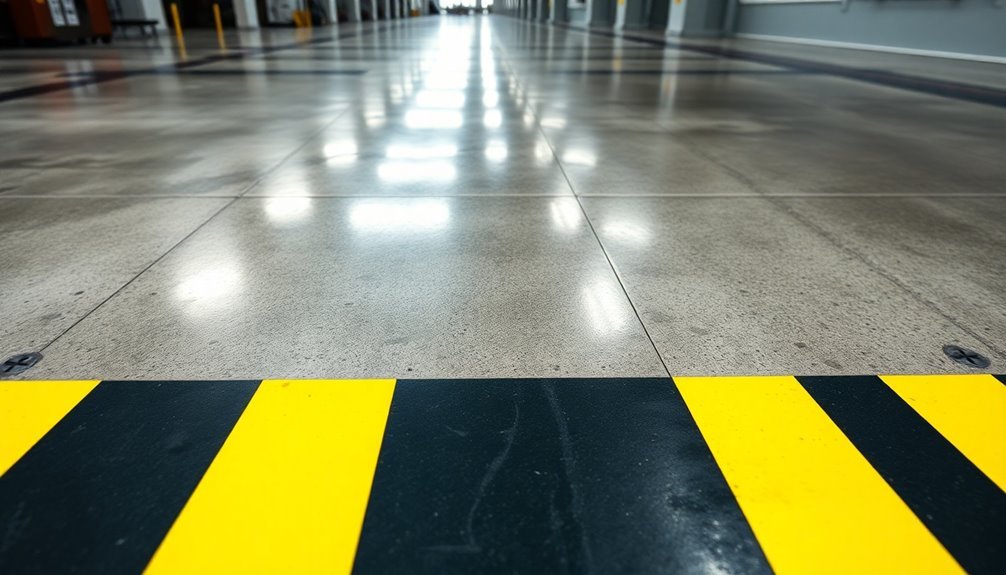Static control floor boundary warning signs help you identify and mark Electrostatic Protected Areas (EPAs) where sensitive electronic components need protection from static discharge. You'll find these signs in bold, vibrant colors with ESD caution symbols and clear text to alert workers and visitors about special handling procedures. They include floor marking tapes, wall signs, and specialized flooring made from static-dissipative materials that meet ANSI/ESD S20.20 standards. When properly installed and maintained, these markers create visible boundaries and pathways within your EPA to prevent costly damage to equipment. Understanding their proper placement and integration can maximize your static control program's effectiveness.
Understanding ESD Floor Boundary Signs

Anyone working with sensitive electronic components knows the critical importance of static control floor boundary signs. These essential markers define Electrostatic Discharge Protected Areas (EPAs) where you'll handle static-sensitive components and equipment.
They're a key part of your thorough ESD control program, helping you maintain safety standards and protect valuable electronic components.
You'll find these boundary signs in various forms, including floor tapes, warning signs, and caution markers. They're designed to provide clear visual cues, using bold and vibrant visuals to make certain you can't miss them. These signs and markers are commonly made with self-adhesive backing for easy installation.
When you're working in industrial environments or high-voltage areas, these signs serve as constant reminders of special handling procedures and safety protocols.
To comply with standard 61340-5-1, you'll need to make sure your boundary signs are properly installed and maintained. The signs you choose should be durable enough to withstand heavy traffic and regular cleaning while maintaining their visibility.
Whether you're marking walkways, defining safe areas, or highlighting EPA boundaries, these signs play an essential role in your facility's ESD control strategy, helping you prevent costly damage to sensitive components and equipment.
Key Features of Warning Signs
Warning signs for static control floor boundaries incorporate distinct features that make them immediately recognizable and effective. You'll notice these signs primarily use yellow or red colors to signal caution, and they're enhanced with ESD caution symbols and bold text that demand attention.
The signs combine graphical elements with clear labeling to guarantee maximum awareness of static-sensitive areas. Regular inspection for damage helps maintain the effectiveness of these safety markers.
When you're installing these warning signs, you'll find various types to suit your needs. They range from ESD floor marking tapes that define safe walkways to heavy-duty aluminum signs for permanent installations. You can customize these signs to match your facility's specific EPA requirements while maintaining compliance with standard 61340-5-1.
You must guarantee proper placement of these signs so they're visible before anyone enters or exits EPAs. They need to be positioned as close to potential hazards as possible, and they should be easily spotted by all personnel.
The signs are designed to meet strict compliance standards, including OSHA and ANSI requirements, while being durable enough to withstand heavy traffic. They're manufactured using RoHS and REACH compliant materials, guaranteeing both safety and longevity in industrial environments.
Types of Static Control Markers

Building on proper warning sign placement, you'll need to understand the various markers used in static control environments. The most common markers include floor marking tapes, specialized flooring, and ESD symbols and labels, each serving distinct purposes in static control management.
Floor marking tapes, typically in fluorescent yellow with black printing, define boundaries and zones within ESD Protected Areas. These durable, anti-static markers help prevent static charge buildup in critical work areas. These tapes adhere well to PVC and concrete floors, withstanding heavy traffic for several months.
Static-control flooring options include carpet, vinyl tile, rubber tile, and epoxy coatings, available in both conductive and static dissipative forms.
For clear identification, you'll encounter two primary ESD symbols: the Susceptibility Symbol (yellow hand in black triangle) for static-sensitive components and the Protective Symbol for items with ESD control properties. The latter uses specific letters to indicate properties: L for Low Charging, D for Static Dissipative, and C for Conductive EPA.
Additional markers include ESD awareness tapes for sealing packages, anti-static tape for general use, and blue ESD tape for specific applications. Remember that standard ESD packaging tapes don't contain anti-static properties and shouldn't be used in EPAs.
Proper Sign Placement and Installation
When implementing static control measures, proper sign placement and installation serve as critical components of an effective ESD protection strategy. You'll need to position ESD warning signs where they're clearly visible before anyone enters the Electrostatic Protected Area (EPA). ESD coordinators manage and maintain comprehensive signage requirements as part of their product list management duties.
For multi-workstation environments, guarantee signs are visible to all personnel, with elevated placement above user benches being particularly effective.
You should complement your signage with ESD floor marking tape to define clear boundaries and walkways within the EPA. The tape you select must be durable enough to withstand heavy foot traffic while maintaining its visibility.
Place your signs as close to potential hazards as possible, and use floor marking tape to outline clearance areas around critical zones.
Don't forget to follow relevant standards like OSHA, ANSI, and 61340-5-1 when installing your signs and floor markings. You'll need to regularly evaluate and maintain these markers to guarantee they remain effective.
Consider using custom signage for specific applications, and remember that your floor markings should clearly communicate safety information while being flexible enough to adapt to your facility's unique layout and requirements.
Safety Standards and Compliance

Proper implementation of static control floor boundary signs requires strict adherence to multiple safety standards and compliance regulations.
You'll need to verify your signage complies with Standard 61340-5-1 for marking Electrostatic Protected Areas (EPAs), while also meeting OSHA and ANSI requirements for warning levels and visual elements.
Your warning signs must incorporate the appropriate color coding – yellow for "CAUTION" and red for "DANGER" – and should be clearly visible before entering or exiting EPAs.
You'll need to combine floor tape with signs to create thorough hazard communication, particularly in areas with electrical panels where you must maintain specific clearances (minimum 3 feet for equipment under 600 volts).
Similar to special purpose districts that address unique neighborhood needs, EPAs require specialized signage and markings to ensure safety in these designated areas.
Don't forget to include ESD labels for equipment handling and storage within EPAs.
Your floor marking tape should be compatible with your facility's flooring type and able to withstand heavy traffic.
You're required to follow regulations from multiple authorities, including OSHA, ANSI, NFPA, and local government standards.
Make sure you're regularly checking for regulatory updates to maintain compliance, as standards can change over time.
Materials and Design Options
Selecting the right materials for static control floor boundary warning signs requires careful thought of both durability and conductivity requirements. You'll find that industrial-grade vinyl with self-adhesive backing serves as the primary material, often enhanced with UltraTuff overlaminate for increased longevity. These materials combine essential static control properties with easy installation features. Regular testing ensures that warning signs maintain electrical resistance standards below 1 x 10E9 ohms.
| Material Type | Primary Use | Key Benefits |
|---|---|---|
| Vinyl Signs | EPA Boundaries | High visibility, durable |
| ESD Tape | Walkway Marking | Easy application, conductive |
| PVC Floor Tiles | Flooring Surface | Static dissipative, wear-resistant |
When choosing your warning sign materials, you'll need to think about the specific demands of your environment. The signs typically come in yellow or red colors with bold text and standardized ESD symbols to maximize visibility. You can select from various sizes and shapes to match your facility's needs, but all materials must meet ANSI/ESD S20.20 compliance standards. For thorough static control, you'll want to evaluate the electrical resistance properties of your chosen materials and verify they're compatible with the footwear used in your facility.
Maintenance of Floor Warning Signs

The maintenance of static control floor boundary warning signs directly impacts their effectiveness and longevity. You'll need to conduct regular inspections to check for damage like rips, tears, wrinkling, and lifted edges that could compromise the signs' visibility and functionality. Setting inspection intervals at half the FDP helps catch issues before sign failure occurs.
When you spot worn-off text, graphics, or any physical damage, don't delay in replacing or reinstalling the affected signs.
To guarantee peak performance and OSHA compliance, implement these key maintenance practices:
- Perform scheduled inspections in high-traffic areas and adjust maintenance frequency based on wear patterns
- Use proper application techniques when installing or replacing signs to maximize their lifespan
- Monitor critical areas, such as high-voltage zones, with extra vigilance and maintain clear visibility at all times
Your preventive maintenance strategy should include regular assessments using appropriate tools to detect potential issues before they become problems. You'll find that this proactive approach not only extends the life of your floor warning signs but also reduces costs associated with emergency replacements and safety incidents.
Remember to continuously evaluate and improve your maintenance procedures based on performance data and changing facility needs.
Static Control System Integration
Successful static control system integration depends on coordinating three essential components: conductive flooring, grounding mechanisms, and boundary identification elements. You'll need to guarantee your conductive flooring maintains a resistance to ground of less than 1.0 x 10^6 ohms and connects properly to your common point ground system.
When you're integrating your static control system, you must coordinate your ESD mats, wrist straps, and foot grounders with your flooring system. Your ESD mats should maintain a resistance between 1.0 x 10^6 and 1.0 x 10^9 ohms, while your wrist straps and foot grounders need to connect directly to the common point ground.
You'll want to clearly mark your EPA boundaries using standardized signs, labels, and floor marking tape. These visual indicators should coordinate with your different flooring materials to create distinct boundaries that are immediately recognizable to all personnel.
Don't forget to install constant monitors throughout your EPA to verify system effectiveness. Remember that your entire static control system must comply with ANSI/ESD S20.20 and TR53 standards, and you'll need to perform regular resistance checks and walking body voltage measurements to guarantee continued functionality.
Frequently Asked Questions
How Long Does It Typically Take to Train Staff on ESD Boundary Protocols?
You'll typically need 45 minutes to complete basic ESD boundary protocol training. This includes learning about EPA boundaries, proper signage recognition, and entry/exit procedures in your manufacturing or assembly environment.
Can Static Control Floor Signs Be Installed Over Existing Non-Esd Floor Markings?
Yes, you can install static control floor signs over existing non-ESD markings, but you'll need to properly clean and prepare the surface first. Make sure to remove old adhesives and check material compatibility.
What Temperature Conditions Affect the Performance of ESD Floor Boundary Signs?
You'll notice that high temperatures can degrade your ESD sign materials, while temperature fluctuations affect adhesion. Both extreme heat and cold can also impact sign performance by altering the conductivity of underlying flooring.
Are There Special Cleaning Requirements for Areas With ESD Floor Boundary Signs?
You'll need to use ESD-specific cleaners and tools for areas with boundary signs. Daily sweep and mop with anti-static equipment, avoid household cleaners, and regularly measure surface resistance to maintain ESD properties.
How Often Should ESD Floor Boundary Signs Be Replaced in High-Traffic Areas?
You should replace ESD floor boundary signs in high-traffic areas more frequently than standard locations. Inspect them quarterly and replace when visibility diminishes. Don't wait until signs are completely faded or damaged.
In Summary
You'll find static control floor boundary warning signs essential for maintaining ESD safety in your facility. They're your first line of defense in alerting personnel about protected areas and required protocols. Remember to regularly inspect and maintain your signs, verify they meet compliance standards, and integrate them effectively with your overall static control system. Proper signage isn't just about regulation—it's about protecting your sensitive equipment and operations.





Leave a Reply